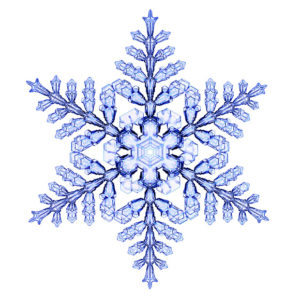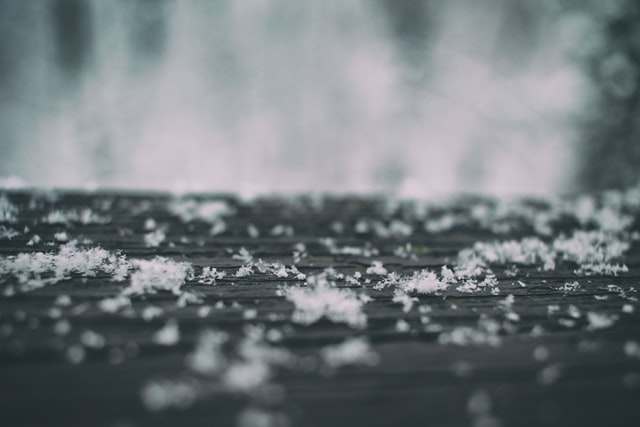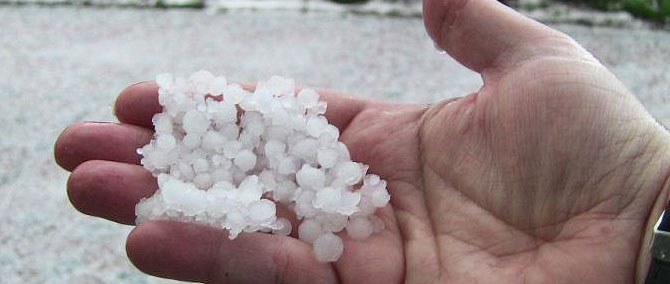Fun Facts About Snowflakes
Fun Facts About Snowflakes
What is a Snowflake?
Snowflakes are a super interesting form of precipitation that usually occur in the cold, wintry months of the year. But contrary to what you might think, snowflakes don’t always have six sides. And similar to the human fingerprint, it is thought that no two snowflakes are ever exactly the same! Also, both the form and shape of a snowflake depends on the temperature and moisture content of the cloud they come from. Snowflakes can be categorized into six main types – plate (flat), column, stars, dendrite (lacy), needle, and capped column. When it is extremely cold the snow is very fine and powdery and snowflakes become quite simple in design, usually needle or rod shaped. When the temperature is near to the freezing point (32 degrees Fahrenheit or 0 degrees Celsius), snowflakes become much larger and a lot more complex in design, for example, an intricate star pattern. Sounds “cool”, huh? Want to know more fun facts about snowflakes? Read on…
Did You Know These Fun Snowflake Facts?
- The world’s largest ever snowflake found to date was 38 centimeters wide and 20 centimeters thick! This snowflake occurred at Fort Keogh, Montana, USA on 28 January 1887.
- Snow is a form of precipitation like rain and sleet.
- To snow the temperature must be below 32 (0) degrees.
- Snowflakes actually start as tiny ice crystals that form from water vapor that freezes in the atmosphere.
- The size of a snowflake depends on how many ice crystals connect together.
- Each snowflake is made up of about 200 ice crystals.
- Snowflakes always have six sides.
- There is no scientific proof that no two snowflakes aren’t exactly alike.
- On average snowflakes fall from the sky at 3-4 miles per hour.
- Close to 80% of the world’s fresh water supply comes from snow and ice.
- Snow didn’t always look white. When coal was used widespread in factories and homes a lot of coal dust traveled through the air. The coal dust was absorbed in the clouds and when it snowed it often looked gray from the air pollution.
- Snow is not actually white but clear. It looks white because of the way the light reflects off of the ice crystals.
- Thundersnow is when it snows while there is thunder and lightning.
- Watermelon snow is snow with algae growing on it. The algae is a reddish color. It is mostly found in the Canadian Rockies.
- On average there are around 105 snowstorms a year that hit the US.
- Snow at the North and South Poles reflect heat into space. The snow acts like a mirror from the sun. The light bounces off of the snow and travels into space.
- Heavy snowfalls are called snowstorms.
- Heavy snowfalls with high winds over 35 miles per hour with limited visibility are called blizzards.
- Billions of snowflakes fall in every snowstorm.
- When the weatherperson predicts a blizzard is coming people buy more cakes, candy and cookies than any other food.
- The most snowfall over a year was on Mount Rainier in the state of Washington, USA. It snowed 1,224 inches from February 19th 1971 – February 19th 1972!
- The most snow to fall in a 24 hour period was 76 inches in Silver Lake, Colorado in 1921.
- The largest snowman was 122 feet tall. It was built-in Maine in 2008.
- The largest snow sculpture ever built was in Heilongjiang Province, China in 2008. It was 656 feet long and 115 feet tall. It took 600 sculptors from 40 countries to build it.
- The snowiest place in the U.S. is Stampede Pass in Washington State. On average it snows 430 inches a year!
- The Wapusk Trail holds the Guinness Book of World Record for the longest seasonal winter road (only functional during winter months). It is 467 miles long and connects Gillam, Monitoba to Peawanuk, Ontario in Canada. The road closes in late March when the weather gets warmer.
- The most popular activity for kids to do in the snow is building a snowman!
Who Is Wilson “Snowflake” Bentley?
“Of all the forms of water the tiny six-pointed crystals of ice called snow are incomparably the most beautiful and varied.”
– Wilson Bentley (1865-1931)
Wilson Bentley was the father of snowflake photography and the main reason we all believe that snowflakes are all six-sided but also uniquely different in shape.
“In 1885, at the age of twenty, Wilson Alwyn Bentley, a farmer who would live all his life in the small town of Jericho in Vermont, gave the world its first ever photograph of a snowflake. Throughout the following winters, until his death in 1931, Bentley would go on to capture over 5000 snowflakes, or more correctly, snow crystals, on film. Despite the fact that he rarely left Jericho, thousands of Americans knew him as The Snowflake Man or simply Snowflake Bentley. Our belief that “no two snowflakes are alike” stems from a line in a 1925 report in which he remarked: “Every crystal was a masterpiece of design and no one design was ever repeated. When a snowflake melted, that design was forever lost.”” -i
“From the time he was a small boy in Vermont, Wilson Bentley saw snowflakes as small miracles. And he determined that one day his camera would capture for others the wonder of the tiny crystal. Bentley’s enthusiasm for photographing snowflakes was often misunderstood in his time, but his patience and determination revealed two important truths: no two snowflakes are alike; and each one is startlingly beautiful. His story is gracefully told and brought to life in lovely woodcuts, giving children insight into a soul who had not only a scientist’s vision and perseverance but a clear passion for the wonders of nature. Snowflake Bentley won the 1999 Caldecott Medal.” – ii
Here are some great books on the amazing snowflake photographer Wilson Bentley.
What Are Snowflakes Made Of?
Snowflakes are really just conglomerations of frozen ice crystals which fall through the Earth’s atmosphere. They begin as snow crystals which develop when microscopic supercooled cloud droplets freeze.
Amazingly, snowflakes appear white in color despite being made of clear ice. This is due to diffuse reflection of the whole spectrum of light by the small crystal facets. The individual ice crystals often have hexagonal symmetry so although the ice is clear, scattering of light by the crystal facets and hollows/imperfections mean that the crystals often appear white in color due to diffuse reflection of the whole spectrum of light by the small ice particles.
Want to know more about snowflakes and how they are actually formed?
This is a great video to learn more about the chemistry of snowflakes…
How Do Temperature and Humidity Determine Snowflake Shape?
Did you know that snowflakes come in a variety of sizes and shapes? Complex shapes emerge as the flake moves through differing temperature and humidity regimes, such that individual snowflakes are nearly unique in structure.
“At -2 °C, simple hexagons and star shapes form. Between -5 and -10 °C, it’s columns. Then below -15 °C, the six-siders appear again. What’s more, each tiny snow crystal experiences a gamut of temperatures and humidities as it falls, and often collides with other crystals. A snowflake can consist of a single crystal, or it can be many thousands of these crystals joined together. “Every snowflake that falls to earth has its own unique history,” says ice physicist John Hallett of the Desert Research Institute in Reno, Nevada.” – iii
So the classic image of a perfectly symmetrical snowflake is rare. The flat, six-sided crystal with delicate filigree patterns of sharp branches occurs in only around one in every 1000 flakes. And when seen in 3D a snowflake is another thing altogether! Researchers have developed a camera system that shoots untouched flakes as they fall from the sky. By grabbing a series of images of the tumbling crystals (its exposure time is 1/40,000th of a second, compared with about 1/200th in normal photography) the camera reveals the true shape diversity of snowflakes.
Have You Ever Heard of Graupel?
Graupel is a snowflake coated with ice. It begins as snow high up in the clouds. The snow then falls into a layer of supercooled water droplets that exist as a liquid even though the air around them is below freezing. When those droplets make contact with the snowflake, they immediately freeze or rime. This results in tiny, white pellets that resemble BBs or little snowballs and are sometimes referred to as small hail or ice pellets. But unlike hail, they are soft, crushable and cause no threat of damage or injury.
Graupel is often confused with sleet because both tend to bounce when they make contact with the ground. You can tell the difference between the two by their color. Graupel is milky white while sleet is usually clear. Graupel usually occurs when temperatures are near or below freezing, but can occasionally occur when surface temperatures are in the 40s.
Our Snowflake Conclusion
Through all of this we hope you learned some cool stuff about snowflakes and how they are formed. You discovered that the most common snow particles are actual visibly irregular. And although the images of near-perfect snowflakes may be more common in pictures (because they are obviously more visually appealing) they are not the norm. You also got a bit of history on Wilson Bentley and his amazing snowflake photography. Plus you found out how temperature and humidity effect the shape of snowflakes and what some of those shapes are called.
With all this cool information we think you can all agree that these little flakes of snow and ice are more than just beautiful to look at. They are also an almost universal symbol of winter used on such things as sweaters, shirts, greeting cards and holiday decorations and make us all think of things like Frosty the Snowman, snowball fights and sledding!
We hope you liked our fun facts about snowflakes and really enjoy your next time out in the snow now that you know how those beloved snowflakes are created!
i – The Snowflake Man of Vermont by Keith C. Heidorn
ii – Snowflake Bentley, Excerpt from Amazon
iii – The great white lie: What snowflakes really look like by Helen Pilcher







Glad you liked our post!